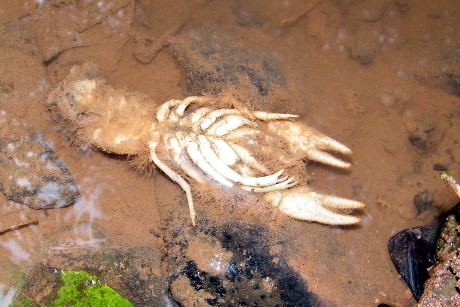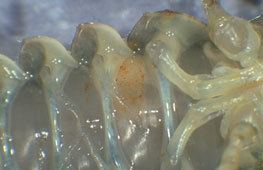Domain Eukaryota Family Leptolegniaceae Rank Species | Superphylum Heterokonta Genus Aphanomyces Higher classification Aphanomyces | |
 | ||
Similar | ||
Crayfish plague, Aphanomyces astaci, is a water mold that infects crayfish, most notably the European Astacus which dies within a few weeks of being infected. When experimentally tested, species from Australia, New Guinea and Japan were also found to be susceptible to the infection.
Contents

History

Crayfish plague first arrived in Europe in Italy in 1859, either with imported crayfish from North America, or in ballast water. After its original introduction in Italy in 1860, it spread quickly through Europe and was discovered in Sweden in 1907, in Spain in 1972, in Norway in 1971, in Great Britain in 1981, in Turkey in 1984 and in Ireland in 1987.

In 1959, to bolster dwindling stocks of native crayfish, the signal crayfish was introduced to Sweden. The signal crayfish was known to be resistant, and it was not recognised at that time that it was a carrier of the disease. After 150 years of contact, no resistance has been discovered in native European crayfish.
Transmission

Implantations of the signal crayfish were the reason for the spread of the disease to United Kingdom and Ireland. Transport of signal crayfish, red swamp crayfish and infected native European freshwater crayfish between waters is the main cause for contamination. Transmission of the disease through items that has been in contact with contaminated water, for example a fishing tool or footwear is also possible. The spores are also sensitive to high or low temperatures. Most authorities have local rules and regulations that the amount of water moved between different waters (in for example a boat) is minimised. It is usually also recommended to only use fishing bait from the same lake when fishing, alternatively freeze it to at least −10 °C (14 °F) for one day before use, if risk for contamination exists. The spores of crayfish plague disappear from an infected water system (connected lakes and rivers) in a few weeks after the last infected crayfish is gone. Reintroduction is then possible, as long as no infected waters are in contact with the lake.
Signs

Infection with Aphanomyces astaci is accompanied by few signs in its early stages, and the first indication of infection may be mortality. In the later stages, the muscles of the tail may appear whitened, or brownish-red where blood cells have encapsulated the hyphae. The effects of the neurotoxins in the oomycete can include appearing in daytime (crayfish are typically nocturnal) and a lack of coordination.
